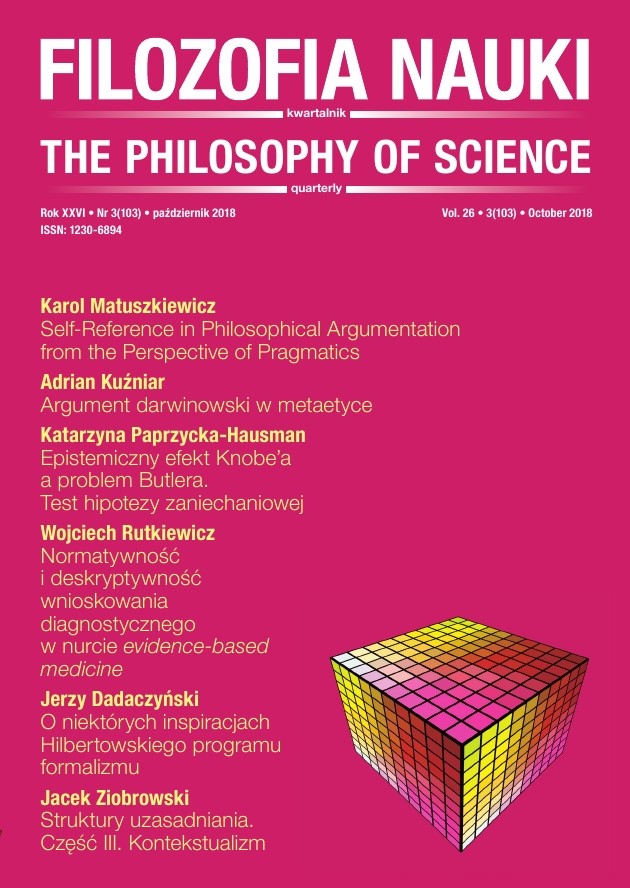Normatywność i deskryptywność wnioskowania diagnostycznego w nurcie evidence-based medicine
DOI:
https://doi.org/10.14394/filnau.2018.0018Słowa kluczowe:
dual-track theory, heuristics, clinical decision making, theory of decision, Bayes TheoremAbstrakt
Evidence-based medicine (EBM) provides basic rules for diagnostic procedures. A physician is required critically to appraise clinical evidence and to internalize the quantitative approach to data processing in her practice. There is a common agreement that knowledge of statistical methods is among the core skills of a competent physician. This includes Bayes Theorem. The key role of statistics in medicine gives rise to a normative way of clinical reasoning. However, many researches point out that medicine practitioners do not follow this normative way. Instead, they use common decision strategies mostly based on heuristics. This situation opens a gap between normative and descriptive aspects of clinical reasoning. Consequently, many experts are prone to draw unfavorable conclusions about rationality of clinical decisions. This paper characterizes normative and descriptive aspects of clinical reasoning regarding the concepts of Bayes Theorem
and heuristics. It differentiates between two interpretations of heuristics: one presented by Amos Tversky and Daniel Kahneman and another by Gerd Gigerenzer. It is argued that clinical decisions based on heuristics are not necessarily flawed and irrational.
Bibliografia
Blumenthal-Barby S. J., Krieger H. (2015), Cognitive Biases and Heuristics in Medical Decision Making. A Critical Review Using a Systematic Search Strategy, "Medical Decision Making" 35(4), 539-557. https://doi.org/10.1177/0272989X14547740
Buschman J. T., Miller K. E. (2007), Top-Down versus Bottom-Up Control of Attention in the Prefrontal and Posterior Cortices, "Science" 315(5820), 1860-1862. https://doi.org/10.1126/science.1138071
Chalmers I. (1993), The Cochrane Collaboration. Preparing, Maintaining, and Disseminating Systematic Reviews of the Effects of Health Care, "Annals of the New York Academy of Sciences" 703(1), 156-165. https://doi.org/10.1111/j.1749-6632.1993.tb26345.x
Cieślińska I. (2014), Nieznajomość matematyki zabija [w:] "Gazeta Wyborcza" 21.11.2014, https://bit.ly/2BDyHaL.
Croskerry P. (2002), Achieving Quality in Clinical Decision Making. Cognitive Strategies and Detection of Bias, "Academic Emergency Medicine Journal" 9(11), 1184-1204. https://doi.org/10.1197/aemj.9.11.1184
Davidoff F. (1999), Standing Statistics Right Side Up, "Annals of Internal Medicine" 130(12), 1019-1021. https://doi.org/10.7326/0003-4819-130-12-199906150-00022
Davidoff F., Haynes B., Sackett D., Smith R. (1995), Evidence Based Medicine. A New Journal to Help Doctors Identify Information They Need, "British Medical Journal" 310, 1085-1086. https://doi.org/10.1136/bmj.310.6987.1085
EBM Working Group (1992), Evidence-Based Medicine. A New Approach to Teaching the Practice of Medicine, "Journal of the American Medical Association" 269(17), 2420-2425.
Elstein A. (1999), Heuristics and Biases. Selected Errors in Clinical Reasoning, "Academic Medicine" 74(7), 791-794.
https://doi.org/10.1097/00001888-199907000-00012
Evans T. B. St. J. (2003), In Two Minds. Dual-Process Accounts of Reasoning, "Trends in Cognitive Sciences" 7(10), 454-459. https://doi.org/10.1016/j.tics.2003.08.012
Gajewski P., Jaeschke R., Brożek J. (red.) (2008), Podstawy EBM, czyli medycyny opartej na danych naukowych dla lekarzy i studentów medycyny, Kraków: Medycyna Praktyczna.
Gawande A. (2012), Potęga checklisty. Jak opanować chaos i zyskać swobodę w działaniu, Kraków: Znak.
Gigerenzer G. (1996), On Narrow Norms and Vague Heuristics. A Reply to Kahneman and Tversky (1996), "Psychological Review" 103(3), 592-596. https://doi.org/10.1037/0033-295X.103.3.592
Gigerenzer G., Brighton H. (2009), Homo Heuristicus. Why Biased Minds Make Better Inferences, "Topics in Cognitive Science" 1(1), 107-143. https://doi.org/10.1111/j.1756-8765.2008.01006.x
Gigerenzer G., Gaissmaier W. (2011), Heuristic Decision Making, "Annual Review of Psychology" 62, 451-482.
https://doi.org/10.1146/annurev-psych-120709-145346
Grossman J., Mackenzie F. (2005), The Randomized Controlled Trial. Gold Standard or Merely a Standard?, "Perspectives in Biology and Medicine" 48(4), 516-534. https://doi.org/10.1353/pbm.2005.0092
Grzybowski A. (2012), Matematyczne modele konfliktu. Wykłady z teorii gier i decyzji, Częstochowa: Wydawnictwo Politechniki Częstochowskiej.
Guyatt G. H. (1991), Evidence-Based Medicine, "ACP Journal Club" 114, A16.
Guyatt G., Haynes R. B., Jaeschke Z. R., Cook D. J., Green L., Naylor C. D., Wilson M. C., Richardson W. S. (2000), User's Guide to the Medical Literature XXV. Evidence-Based Medicine. Principles for Applying the User's Guides to Patient Care, "Journal of American Medical Association" 284(10), 1290-1296. https://doi.org/10.1001/jama.284.10.1290
Kahneman D. (2012), Pułapki myślenia. O myśleniu szybkim i wolnym, tłum. P. Szymczak, Poznań: Media Rodzina.
Kestin I. (2015), Statistics in Medicine, "Anaesthesia and Intensive Care Medicine" 16(4), 200-207.
https://doi.org/10.1016/j.mpaic.2015.01.007
Kuhn T. (2009), Struktura rewolucji naukowych, tłum. H. Ostromęcka, Warszawa: Fundacja Aletheia.
Kuklin B. (2006), Probability Misestimates in Medical Care, "Arkansas Law Review" 59, 527-554.
Miettinen S. O. (2001), The Modern Scientific Physician. 3. Scientific Diagnosis, "Canadian Medical Association Journal"18(165), 781-782.
Monahan J. (2007), Statistical Literacy. A Prerequisite for Evidence-Based Medicine, "Psychological Science in the Public Interest" 8(2), s. i-ii.
Redelmeier A. D., Shafir E. (1995), Medical Decision Making in Situations That Offer Multiple Alternatives, "Journal of the American Medical Association", 273(4), 302-305. https://doi.org/10.1001/jama.1995.03520280048038 https://doi.org/10.1001/jama.273.4.302
Reszka P. (2017), Mali bogowie, Warszawa: Czerwone i Czarne.
Rosenberg W., Donald A. (1995), Evidence Based Medicine. An Approach to Clinical Problem-Solving, "British Medical Journal" 310(6987), 1122-1126. https://doi.org/10.1136/bmj.310.6987.1122
Rzepiński T. (2012), Ewidencja empiryczna w procesie podejmowania decyzji klinicznych, "Filozofia Nauki" 20(3) [79], 13-33.
Sackett D., Rosenberg W. (1995), The Need for Evidence Based Medicine, "Journal of the Royal Society of Medicine" 88(1), 620-624.
Sackett D., Rosenberg W., Gray M. A. J., Haynes R. B., Richardson W. S. (1996), Evidence Based Medicine. What It Is and What It Isn't, "British Journal Medicine" 312(7023), 71-72. https://doi.org/10.1136/bmj.312.7023.71
Stanovich E. K., Toplak E. M. (2012), Defining Features versus Incidental Correlates of Type 1 and Type 2 Processing, "Mind & Society" 11(1), 3-13. https://doi.org/10.1007/s11299-011-0093-6
Stanovich E. K., West F. R. (2000), Individual Differences in Reasoning. Implications for the Rationality Debate?, "Behavioral and Brain Sciences" 23(5), 645-726. https://doi.org/10.1017/S0140525X00003435
Switzer S. S., Horton J. N. (2007), What Your Doctor Should Know about Statistics (but Perhaps Doesn't), "Chance" 20(1), 17-21. https://doi.org/10.1080/09332480.2007.10722826
Szumowski W. (2005), Filozofia medycyny, Kęty: Antyk.
Tatoń J., Czech A. (2002), Diagnostyka internistyczna. Podręcznik dla lekarzy i studentów, Warszawa: Wydawnictwo Lekarskie PZWL.
Tversky A., Kahneman D. (1973), Availability. A Heuristic for Judging Frequency and Probability, "Cognitive Psychology" 5(2), 207-232. https://doi.org/10.1016/0010-0285(73)90033-9
Tversky A., Kahneman D. (1974), Judgement under Uncertainty. Heuristics and Biases, "Science" 185(4157), 1154-1131. https://doi.org/10.1126/science.185.4157.1124
Tversky A., Kahneman D. (1981), The Framing Decision and the Psychology of Choice, "Science" 211(4481), 453-458. https://doi.org/10.1126/science.7455683
Tversky A., Kahneman D. (1986), Rational Choice and the Framing of Decisions, "The Journal of Business" 59(4), S251-S278. https://doi.org/10.1086/296365
Wegwarth O., Gaissmaier W., Gigerenzer G. (2009), Smart Strategies for Doctors and Doctors-in-Training. Heuristics in Medicine, "Medical Education" 43(8), 721-728. https://doi.org/10.1111/j.1365-2923.2009.03359.x
West F. A., West R. R. (2002), Clinical Decision-Making. Coping with Uncertainty, "Postgraduate Medical Journal" 78(920), 319-321. https://doi.org/10.1136/pmj.78.920.319
Wolf M. F., Gruppen D. L., Billi E. J. (1985), Differential Diagnosis and the Competing — Hypotheses Heuristic. A Practical Approach to Judgement under Uncertainty and Bayesian Probability, "Journal of American Medical Association" 253(19), 2858-2862. https://doi.org/10.1001/jama.1985.03350430070028
Worrall J. (2010), Evidence. Philosophy of Science Meets Medicine, "Journal of Evaluation in Clinical Practice" 16(2), 356-362. https://doi.org/10.1111/j.1365-2753.2010.01400.x
Wulff R. H., Gøetzsche C. P. (2005), Racjonalna diagnoza i leczenie. Wprowadzenie do medycyny wiarygodnej czyli Evidence-Based Medicine, tłum. Z. Szawarski, Łódź: AKTIS.



















 Filozofia Nauki | ISSN 1230-6894 | e-ISSN 2657-5868
Filozofia Nauki | ISSN 1230-6894 | e-ISSN 2657-5868